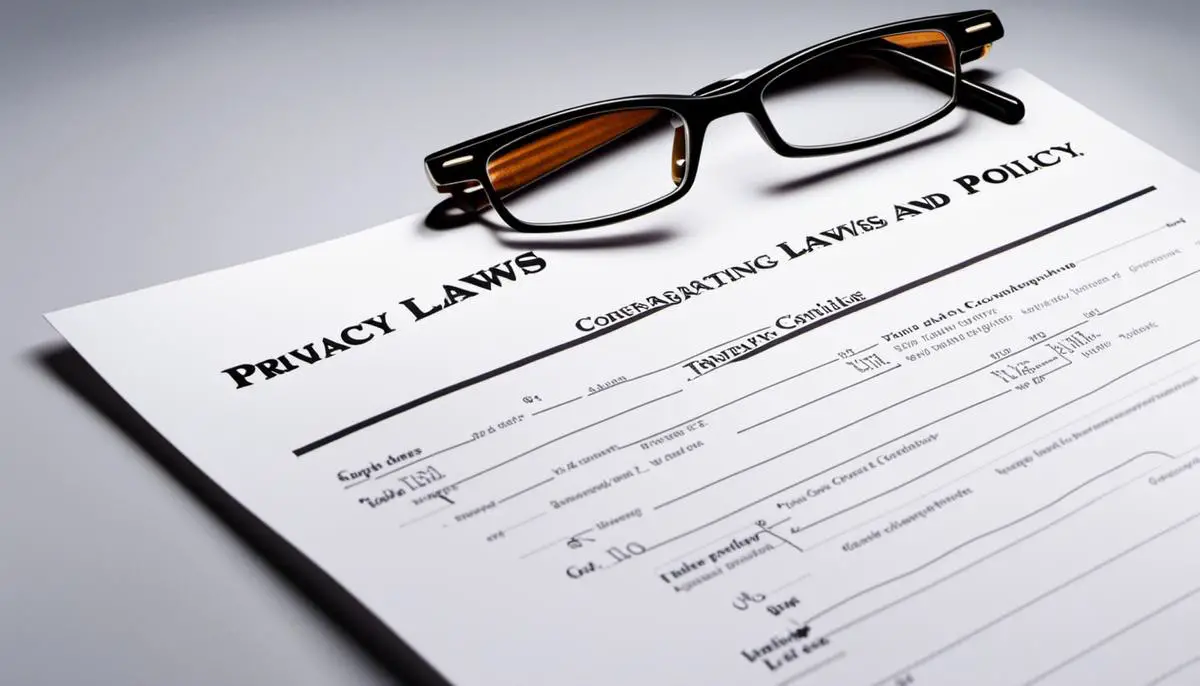In an age where personal data has become one of the most valuable commodities, understanding how to protect the privacy of individuals interacting with your website is essential. As a website owner, creating a robust and transparent privacy policy demonstrates not only a legal compliance with existing privacy laws such as the GDPR or CCPA but also reveals your commitment to respect and protect the personal data of your users. This journey begins with understanding these privacy laws and progresses through identifying the type of data your website collects, clarifying the uses this information is put to, right to the sketching and reviewing of your privacy policy.
Understanding Privacy Laws
Understanding Global Privacy Laws
When creating a privacy policy for your website, understanding of the General Data Protection Regulation (GDPR) is crucial. GDPR is a European Union regulation that protects the privacy and personal data of EU citizens. It dictates that companies need to have a justified purpose for collecting data, and they must ensure transparency about how that data will be used.
GDPR also gives individuals the right to control the information companies have about them, affecting websites globally, as it applies to any organization that collects and processes the data of EU citizens, regardless if the organization is EU-based or not.
Understanding U.S. Privacy Laws
In the United States, there’s no singular, comprehensive federal law regulating the collection and use of personal data. However, several federal laws that focus on specific sectors or certain types of personal data come into play. Hence, you must familiarize yourself with these laws depending on the nature of your website. Key ones include the Health Insurance Portability and Accountability Act (HIPAA), which applies to healthcare-related data, and the Children’s Online Privacy Protection Rule (COPPA), which governs data collected online from children under 13.
State-Specific Privacy Laws
Certain U.S. states have additional laws in place to protect their residents’ online data privacy. California set the trend with its California Consumer Privacy Act (CCPA). The CCPA, in effect since 2020, grants California residents several rights regarding their personal data, including the right to deletion, opt-out, and non-discrimination for exercising their privacy rights. Other states, like Nevada and Maine, also have specific data protection laws. It’s important to be aware of these state-based laws and incorporate them into your privacy policy, as required.
Understanding Privacy Laws for Specific Industries
If your website operates within certain industries, such as healthcare or finance, you’ll need to understand industry-specific privacy laws. Health care organisations have to adhere to the Health Insurance Portability and Accountability Act (HIPAA) for patient data. Financial institutions must comply with the Gramm-Leach-Bliley Act (GLBA). Hence, in-depth knowledge about these regulations is crucial.
FTC Guidelines on Privacy Policies
The Federal Trade Commission (FTC) does not require privacy policies in general, however, they require the truthfulness of statements in privacy policies i.e., to not be misleading. If a company discloses a privacy policy and fails to abide by it, the FTC can charge the company with deceptive practices.
Drafting Your Privacy Policy
Once you have familiarized yourself with the relevant laws, regulations, and guidelines, you can start drafting your privacy policy. The policy should include what information is being collected, how it’s being used, if or how it’s shared, and how users can control their information. It’s always recommended to use simple, clear language in your privacy policy to ensure your users can easily understand the terms and conditions of your website.

Identifying the Type of Information You Collect
Identifying Type of Information Collected
In the course of setting up your privacy policy, the first step is to establish and understand which type of personal data your website collects from its users. Data can be grouped into two broad categories: identifiable information and non-identifiable information.
Identifiable information
Identifiable information consists of personal details that directly identify a user. These may include user credentials such as name, phone number, email address, or physical address. It may also include more passive data like a user’s IP address. If your website has features requiring user sign-ins or contact forms, you’re likely handling this type of personal data.
Non-identifiable information
On the other hand, non-identifiable information doesn’t directly reveal a user’s identity. This can consist of aggregated data about user behavior on the website or demographic information. Examples include the number of clicks a user makes on your website, the duration of their visit, or the browser type they are using. This is often collected via cookies, so if your website employs cookies for analytics or functionality purposes, then you’ll be managing this type of data.
Additionally, if your website hosts third-party tools or plugins like a social media share button or embedded video player, you may also be indirectly collecting user data. Such third-party services may gather information you may not directly handle, but it’s still associated with your website and should be addressed in your privacy policy.
Another crucial point to consider is whether your website collects sensitive personal data. This includes details like credit card information, social security numbers, or health information. These are subject to stricter regulations and therefore demand a high level of data protection.
Once you have identified the type of information collected, your privacy policy should clearly outline this. Transparency is crucial when informing your users what kind of information is being collected, how it’s collected, and why it’s being collected.

Clarifying the Use of Collected Information
Clarification of Information Use
One of the primary objectives of this privacy policy is to illustrate how the acquired information will be utilized. It’s not simply a matter of indiscriminately collecting data but doing so for specific, described purposes. This data collection happens because it is essential for improving our services, enhancing user experiences, or ensuring the security of our users and the system.
The data gathered will be accessed mainly by our internal team; this includes but is not limited to our development team, marketing department, and customer service unit. Personnel will only access the data if it’s necessary for their work, and they adhere to strict privacy protocols and confidentiality agreements.
Data Sharing Conditions
Our aim is to assure you that the data collected will be handled with the utmost confidentiality. However, under certain circumstances, it might become necessary to disclose this information. Some of these conditions include:
- Legal Requirements — We may disclose information if required to do so by law or in response to a subpoena or court order.
- To Protect Our Rights and Interests — There may be scenarios where we need to share your data to protect our legal rights, such as during fraud investigations or dispute resolution.
- With Your Consent — We also share information when you have explicitly given us permission to do so. This can include promotional collaborations with partners or third-party service integrations you’ve opted into.
In all these scenarios, we will strive to use only as much information as necessary, preserving your privacy to the greatest degree possible. The process will be transparent, with users notified – unless it’s legally prohibited – when and why the data is being disclosed.

Drafting and Reviewing the Privacy Policy
Understanding Privacy Laws and Guidelines
Knowledge of privacy laws and guidelines is vital in drafting a comprehensive privacy policy. Start by familiarizing yourself with the GDPR (Global Data Protection Regulation) rules if your website caters to EU customers, as well as other location-specific regulations like the CCPA (California Consumer Privacy Act). Not adhering to these laws can lead to heavy fines and penalties.
Identifying Personal Information
Decide what personal information your website collects from its users. This could include names, email addresses, contact numbers, physical addresses, IP addresses, cookie data, and demographic details like age and gender. You must also establish the purposes for collecting this information, whether it’s for improving user experience, marketing purposes, or website optimization.
Drafting Your Privacy Policy
Start off by defining the term ‘personal information’ as per your understanding. Then, explain the precise type of data you collect from users and the reason behind the collection. State clearly whether you share this information with another party or retain it for internal use only. Your policy should also detail if the users have a choice to opt out and describe the measures taken to protect user information.
Use of Cookies and Third-Party Links
In case your website uses cookies, disclose it within the policy. Explain what cookies are, why your website uses them, and how users can deactivate them. If your website includes links to other sites, mention that your privacy policy does not apply to third-party websites.
Review of the Privacy Policy
Once you draft the privacy policy, review it meticulously for any gaps or misleading statements. The language used should be simple and lucid, free of any legal jargon that may confuse users. The policy must be easily accessible on your website.
Update and Communicate Changes
It is equally important to periodically review and update your privacy policy, especially when you make new changes to your website or data handling policies. Whenever these changes occur, it is important to communicate them to your users. Your privacy policy should indicate the date of the latest update.
Legal Compliance
Lastly, have a legal professional review the policy to ensure it complies with all applicable laws and regulations. Non-compliance could lead to heavy penalties and can damage your reputation. Don’t hesitate to get legal assistance; it ensures that your website’s privacy policy is legally sound and user-friendly.

Photo by bernardhermant on Unsplash
The process of creating a comprehensive privacy policy requires mindful and deliberate steps. Understanding the privacy laws applicable to your situation sets a solid foundation, followed by recognizing the nature of data you collect from users. An essential step revolves around articulating how this data is used and who will have access to it, while also outlining the terms for data sharing. While drafting the policy, studying successful models can offer substantial insights. A final scrutiny must confirm its legal compliance and all-inclusiveness, ensuring it leaves no room for misinterpretation or ambiguity. Remember, the objective of a privacy policy isn’t simply to assure legal conformity but to exemplify your commitment to safeguarding user data, an indication of reliability that resonates strongly with your users and instills their trust in your website.
